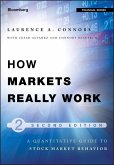Mind Over Markets (eBook, PDF)
Power Trading with Market Generated Information, Updated Edition


Alle Infos zum eBook verschenken

Mind Over Markets (eBook, PDF)
Power Trading with Market Generated Information, Updated Edition
- Format: PDF
- Merkliste
- Auf die Merkliste
- Bewerten Bewerten
- Teilen
- Produkt teilen
- Produkterinnerung
- Produkterinnerung

Hier können Sie sich einloggen

Bitte loggen Sie sich zunächst in Ihr Kundenkonto ein oder registrieren Sie sich bei bücher.de, um das eBook-Abo tolino select nutzen zu können.
A timely update to the book on using the Market Profile method to trade Emerging over twenty years ago, Market Profile analysis continues to realize a strong following among active traders. The approach explains the underlying dynamics and structure of markets, identifies value areas, price rejection points, and measures the strength of buyers and sellers. Unlike more conventional forms of technical analysis, Market Profile is an all-encompassing approach, and Mind Over Markets, Updated Edition provides traders with a solid understanding of it. Since the first edition of Mind Over…mehr
- Geräte: PC
- mit Kopierschutz
- eBook Hilfe
- Größe: 16.73MB
![Move Your Mind (eBook, PDF) Move Your Mind (eBook, PDF)]() Nick BracksMove Your Mind (eBook, PDF)13,99 €
Nick BracksMove Your Mind (eBook, PDF)13,99 €![Master Your Mind (eBook, PDF) Master Your Mind (eBook, PDF)]() Roger SeipMaster Your Mind (eBook, PDF)14,99 €
Roger SeipMaster Your Mind (eBook, PDF)14,99 €![Mind Games (eBook, PDF) Mind Games (eBook, PDF)]() Jeff GroutMind Games (eBook, PDF)8,99 €
Jeff GroutMind Games (eBook, PDF)8,99 €![Decoding the New Consumer Mind (eBook, PDF) Decoding the New Consumer Mind (eBook, PDF)]() Kit YarrowDecoding the New Consumer Mind (eBook, PDF)17,99 €
Kit YarrowDecoding the New Consumer Mind (eBook, PDF)17,99 €![Make Up Your Mind (eBook, PDF) Make Up Your Mind (eBook, PDF)]() Hal MoozMake Up Your Mind (eBook, PDF)16,99 €
Hal MoozMake Up Your Mind (eBook, PDF)16,99 €![How Markets Really Work (eBook, PDF) How Markets Really Work (eBook, PDF)]() Larry ConnorsHow Markets Really Work (eBook, PDF)33,99 €
Larry ConnorsHow Markets Really Work (eBook, PDF)33,99 €![Rumors in Financial Markets (eBook, PDF) Rumors in Financial Markets (eBook, PDF)]() Mark SchindlerRumors in Financial Markets (eBook, PDF)50,99 €
Mark SchindlerRumors in Financial Markets (eBook, PDF)50,99 €-
-
-
Dieser Download kann aus rechtlichen Gründen nur mit Rechnungsadresse in A, B, BG, CY, CZ, D, DK, EW, E, FIN, F, GR, HR, H, IRL, I, LT, L, LR, M, NL, PL, P, R, S, SLO, SK ausgeliefert werden.
- Produktdetails
- Verlag: John Wiley & Sons
- Seitenzahl: 368
- Erscheinungstermin: 25. Juni 2013
- Englisch
- ISBN-13: 9781118659786
- Artikelnr.: 39062594
- Verlag: John Wiley & Sons
- Seitenzahl: 368
- Erscheinungstermin: 25. Juni 2013
- Englisch
- ISBN-13: 9781118659786
- Artikelnr.: 39062594
7 Laying the Foundation 9 The Auction 9 Organizing the Day 10 Challenging
the Rules 15 The Role of the Marketplace 16 Going with the Crowd 17
Introduction to Day Timeframe Structure 19 Normal Day 19 Dynamics 19
Structural Characteristics 21 Normal Variation of a Normal Day 21 Dynamics
21 Structural Characteristics 23 Trend Day 23 Dynamics 23 Structural
Characteristics 23 Double-Distribution Trend Day 25 Dynamics 25 Structural
Characteristics 25 Nontrend Day 27 Dynamics 27 Structural Characteristics
27 Neutral Day 27 Dynamics 27 Structural Characteristics 28 Day Type
Summary 31 CHAPTER 3 Advanced Beginner 33 Building the Framework 34 The Big
Picture: Market Structure, Trading Logic, and Time 34 A Synthesis:
Structure, Time, and Logic 35 Ease of Learning 36 Amount of Information 36
Recognition Speed 37 Trade Location 37 Confidence Level 37 Summary 38
Evaluating Other Timeframe Control 38 Other Timeframe Control on the
Extremes 40 Tails (or Extremes) 40 Range Extension 40 Other Timeframe
Control in the Body of the Profile 40 TPO 41 Initiative versus Responsive
Activity 45 Trending versus Bracketed Markets 49 Key Elements--A Brief
Discussion 51 Trending Markets 54 Bracketed Markets 54 The Two Big
Questions 56 CHAPTER 4 Competent 59 Doing the Trade 59 Section I 60 Day
Timeframe Trading 60 Day Timeframe Directional Conviction 61 Opening Call
61 The Open 62 The Open as a Gauge of Market Conviction 63 Open-Drive 63
Open-Test-Drive 65 Open-Rejection-Reverse 68 Open-Auction 69 Open-Auction
in Range 70 Open-Auction out of Range 71 Summary 73 Opening's Relationship
to Previous Day--Estimating Daily Range Potential 74 Open within
Value--Acceptance 75 Rejection (Breakout) 79 Open outside of Value but
within Range--Acceptance 80 Rejection (Breakout) 83 Open outside of
Range--Acceptance 84 Rejection 85 Summary 85 April 13,1989 86 Crude Oil 87
S&P 500 87 Gold 90 Japanese Yen 92 Soybeans 92 Treasury Bonds 92 Summary 95
Day Timeframe Auction Rotations 96 Two-Timeframe Markets 97 One-Timeframe
Markets 97 Using Auction Rotations to Evaluate Other Timeframe Control 97
Structure 99 Half-Hour Auctions 100 Extremes 100 Range Extension 101 Time
101 Identifying Timeframe Transition 102 December Swiss Franc, October 12,
1987 103 Y to E: One-Timeframe Buying 104 E: Time 104 Y to F: Auction Test
104 G: Transition Confirmation 104 E to H: One-Timeframe Selling 105 H:
Auction Test 105 I: Transition Confirmation 105 H-J: One-Timeframe Buying
105 Summary 105 Auction Failures 105 Excess 110 Signs of Excess 111 The
Rotation Factor 112 Monitoring the POC or Fairest Price 115 9:30 a.m.
Figure 4.30 116 10:00 a.m. Figure 4.31 118 10:30 a.m. Figure 4.32 119 Noon
Figure 4.33 119 2:00 p.m. Figure 4.34 119 The Close 120 Day Timeframe
Visualization and Pattern Recognition 122 Short-Covering Rallies 123
Long-Liquidation Breaks 127 Summary of Short Covering and Long Liquidation
128 Ledges 129 Summary 130 High- and Low-Volume Areas 131 High-Volume Areas
131 Identifying High-Volume Levels 132 High-Volume Examples 134 Low-Volume
Areas 138 Low-Volume Examples 140 Summary 144 Summary--Day Timeframe
Trading 145 Section II 145 Long-Term Trading 145 Long-Term Directional
Conviction 146 Attempted Direction: Which Way Is the Market Trying to Go?
146 Auction Rotations 147 Range Extension 147 Long-Term Excess 150 Island
Days 152 Long-Term Tails 152 Gaps 155 Summary 155 Buying/Selling Composite
Days 155 Summary 157 Directional Performance: Is the Market Doing a Good
Job in its Attempts to Get There? 157 Volume 158 Evaluating Changes in
Volume 158 Volume as a Measure of Directional Performance 158 Value-Area
Placement 159 Evaluating Directional Performance through Combined Volume
and Value-Area Placement 160 Value-Area Width 169 Summary: Long-Term
Activity Record 171 Long-Term Auction Rotations 183 Brackets 183 Trade
Location in a Bracketed Market 188 Rule 1: Monitor Market Direction and
Location within the Current Bracket 189 Rule 2: Markets Generally Test the
Bracket Extreme More Than Once 190 Rule 3: Markets Fluctuate within
Bracketed Regions 190 Rule 4: Monitor Activity Near the Bracket Extremes
for Acceptance/Rejection 192 Transition: Bracket to Trend 192 Trends 193
Trade Location in a Trending Market 193 Monitoring Trends for Continuation
196 Transition: Trend to Bracket 197 Detailed Analysis of a Developing
Market 201 Bracket Reference Points 201 Region A (Figure 4.87) 203 Region B
(Figure 4.88) 205 Region C (Figure 4.89) 207 Region D (Figure 4.90) 208
Long-Term Auction Failures 210 Long-Term Short Covering and Long
Liquidation 214 Applications 224 Corrective Action 225 The Function of
Corrective Action 226 Summary 228 Long-Term Profiles 228 Using Long-Term
Profiles 229 The Long-Term Profile in Action 229 Region A (Figures 4.98 and
4.99) 231 Region B (Figures 4.100 and 4.101) 235 Summary 238 Special
Situations 238 3 to I Days 239 Neutral-Extreme Days 241 The Value-Area Rule
244 Summary 246 Spikes 247 Acceptance versus Rejection 247 Openings within
the Spike 247 Openings outside the Spike 249 Bullish Openings 249 Bearish
Openings 252 Spike Reference Points 252 Balance-Area Breakouts 252 Gaps 260
Day Timeframe Significance of Gaps 260 Summary 265 Markets to Stay Out Of
265 Nontrend Days 266 Nonconviction Days 266 Long-Term Nontrend Markets 267
News-Influenced Markets 269 Summary 269 News 269 Summary 274 Beyond the
Competent Trader 275 CHAPTER 5 Proficient 277 Self-Understanding: Becoming
a Successful Trader 279 Self-Observation 281 The Whole-Brained Trader 282
The Left Hemisphere 283 The Right Hemisphere 283 Combining the Two
Hemispheres 283 Strategy 284 A Business Strategy 285 Capital 285 Location
286 Timing 286 Information 287 Know Your Competition 287 Know Yourself 288
Consistent, Daily Execution 288 Inventory 288 Risk 289 Goals 290 Record
Keeping and Performance 290 Dedication 290 Applications 291 Summary 292
CHAPTER 6 The Expert Trader 295 CHAPTER 7 Experience 297 Set Aside Your
Expectations 297 Mind over Markets in Profile 298 Market-Understanding and
Self-Understanding 300 Perfect Practice Makes Perfect 300 Blinded by Price
300 Be Prepared 301 Perspective 302 Overnight Inventory 305 Gaps Can Be
Gold 307 Gaining an Edge 308 The Fairest Price Revealed 309 Thinking
Statistically 311 The Trader's Dilemma 311 The Most Important Omission from
the First Printing in 1990 312 Emotional Markets 313 A Landscape View of
the Market 314 Personal Evolution 315 Hierarchy of Information 316
Timeframe Control--Who Is Dominating the Current Session? 317 Markets Are
Visual 318 Destination Trades 319 The Opening 319 Trends 320 Daily
Perspective 322 Cognitive Dissonance 322 Imagination 325 False Certainty
326 Anomalies 326 Market Logic 328 We Are All Day Traders 329 APPENDIX 1
Value-Area Calculation 331 Volume Value-Area Calculation 331 TPO Value-Area
Calculation 332 APPENDIX II TPO versus Volume Profiles 335 Single Price
Level Distortions 336 End of Day Total Volume versus Ongoing Volume
throughout the Day 337 Anomalies 337 Too Focused on Volume 339 Conclusion
339 Suggested Readings 341 About the Authors 343 Index 345
7 Laying the Foundation 9 The Auction 9 Organizing the Day 10 Challenging
the Rules 15 The Role of the Marketplace 16 Going with the Crowd 17
Introduction to Day Timeframe Structure 19 Normal Day 19 Dynamics 19
Structural Characteristics 21 Normal Variation of a Normal Day 21 Dynamics
21 Structural Characteristics 23 Trend Day 23 Dynamics 23 Structural
Characteristics 23 Double-Distribution Trend Day 25 Dynamics 25 Structural
Characteristics 25 Nontrend Day 27 Dynamics 27 Structural Characteristics
27 Neutral Day 27 Dynamics 27 Structural Characteristics 28 Day Type
Summary 31 CHAPTER 3 Advanced Beginner 33 Building the Framework 34 The Big
Picture: Market Structure, Trading Logic, and Time 34 A Synthesis:
Structure, Time, and Logic 35 Ease of Learning 36 Amount of Information 36
Recognition Speed 37 Trade Location 37 Confidence Level 37 Summary 38
Evaluating Other Timeframe Control 38 Other Timeframe Control on the
Extremes 40 Tails (or Extremes) 40 Range Extension 40 Other Timeframe
Control in the Body of the Profile 40 TPO 41 Initiative versus Responsive
Activity 45 Trending versus Bracketed Markets 49 Key Elements--A Brief
Discussion 51 Trending Markets 54 Bracketed Markets 54 The Two Big
Questions 56 CHAPTER 4 Competent 59 Doing the Trade 59 Section I 60 Day
Timeframe Trading 60 Day Timeframe Directional Conviction 61 Opening Call
61 The Open 62 The Open as a Gauge of Market Conviction 63 Open-Drive 63
Open-Test-Drive 65 Open-Rejection-Reverse 68 Open-Auction 69 Open-Auction
in Range 70 Open-Auction out of Range 71 Summary 73 Opening's Relationship
to Previous Day--Estimating Daily Range Potential 74 Open within
Value--Acceptance 75 Rejection (Breakout) 79 Open outside of Value but
within Range--Acceptance 80 Rejection (Breakout) 83 Open outside of
Range--Acceptance 84 Rejection 85 Summary 85 April 13,1989 86 Crude Oil 87
S&P 500 87 Gold 90 Japanese Yen 92 Soybeans 92 Treasury Bonds 92 Summary 95
Day Timeframe Auction Rotations 96 Two-Timeframe Markets 97 One-Timeframe
Markets 97 Using Auction Rotations to Evaluate Other Timeframe Control 97
Structure 99 Half-Hour Auctions 100 Extremes 100 Range Extension 101 Time
101 Identifying Timeframe Transition 102 December Swiss Franc, October 12,
1987 103 Y to E: One-Timeframe Buying 104 E: Time 104 Y to F: Auction Test
104 G: Transition Confirmation 104 E to H: One-Timeframe Selling 105 H:
Auction Test 105 I: Transition Confirmation 105 H-J: One-Timeframe Buying
105 Summary 105 Auction Failures 105 Excess 110 Signs of Excess 111 The
Rotation Factor 112 Monitoring the POC or Fairest Price 115 9:30 a.m.
Figure 4.30 116 10:00 a.m. Figure 4.31 118 10:30 a.m. Figure 4.32 119 Noon
Figure 4.33 119 2:00 p.m. Figure 4.34 119 The Close 120 Day Timeframe
Visualization and Pattern Recognition 122 Short-Covering Rallies 123
Long-Liquidation Breaks 127 Summary of Short Covering and Long Liquidation
128 Ledges 129 Summary 130 High- and Low-Volume Areas 131 High-Volume Areas
131 Identifying High-Volume Levels 132 High-Volume Examples 134 Low-Volume
Areas 138 Low-Volume Examples 140 Summary 144 Summary--Day Timeframe
Trading 145 Section II 145 Long-Term Trading 145 Long-Term Directional
Conviction 146 Attempted Direction: Which Way Is the Market Trying to Go?
146 Auction Rotations 147 Range Extension 147 Long-Term Excess 150 Island
Days 152 Long-Term Tails 152 Gaps 155 Summary 155 Buying/Selling Composite
Days 155 Summary 157 Directional Performance: Is the Market Doing a Good
Job in its Attempts to Get There? 157 Volume 158 Evaluating Changes in
Volume 158 Volume as a Measure of Directional Performance 158 Value-Area
Placement 159 Evaluating Directional Performance through Combined Volume
and Value-Area Placement 160 Value-Area Width 169 Summary: Long-Term
Activity Record 171 Long-Term Auction Rotations 183 Brackets 183 Trade
Location in a Bracketed Market 188 Rule 1: Monitor Market Direction and
Location within the Current Bracket 189 Rule 2: Markets Generally Test the
Bracket Extreme More Than Once 190 Rule 3: Markets Fluctuate within
Bracketed Regions 190 Rule 4: Monitor Activity Near the Bracket Extremes
for Acceptance/Rejection 192 Transition: Bracket to Trend 192 Trends 193
Trade Location in a Trending Market 193 Monitoring Trends for Continuation
196 Transition: Trend to Bracket 197 Detailed Analysis of a Developing
Market 201 Bracket Reference Points 201 Region A (Figure 4.87) 203 Region B
(Figure 4.88) 205 Region C (Figure 4.89) 207 Region D (Figure 4.90) 208
Long-Term Auction Failures 210 Long-Term Short Covering and Long
Liquidation 214 Applications 224 Corrective Action 225 The Function of
Corrective Action 226 Summary 228 Long-Term Profiles 228 Using Long-Term
Profiles 229 The Long-Term Profile in Action 229 Region A (Figures 4.98 and
4.99) 231 Region B (Figures 4.100 and 4.101) 235 Summary 238 Special
Situations 238 3 to I Days 239 Neutral-Extreme Days 241 The Value-Area Rule
244 Summary 246 Spikes 247 Acceptance versus Rejection 247 Openings within
the Spike 247 Openings outside the Spike 249 Bullish Openings 249 Bearish
Openings 252 Spike Reference Points 252 Balance-Area Breakouts 252 Gaps 260
Day Timeframe Significance of Gaps 260 Summary 265 Markets to Stay Out Of
265 Nontrend Days 266 Nonconviction Days 266 Long-Term Nontrend Markets 267
News-Influenced Markets 269 Summary 269 News 269 Summary 274 Beyond the
Competent Trader 275 CHAPTER 5 Proficient 277 Self-Understanding: Becoming
a Successful Trader 279 Self-Observation 281 The Whole-Brained Trader 282
The Left Hemisphere 283 The Right Hemisphere 283 Combining the Two
Hemispheres 283 Strategy 284 A Business Strategy 285 Capital 285 Location
286 Timing 286 Information 287 Know Your Competition 287 Know Yourself 288
Consistent, Daily Execution 288 Inventory 288 Risk 289 Goals 290 Record
Keeping and Performance 290 Dedication 290 Applications 291 Summary 292
CHAPTER 6 The Expert Trader 295 CHAPTER 7 Experience 297 Set Aside Your
Expectations 297 Mind over Markets in Profile 298 Market-Understanding and
Self-Understanding 300 Perfect Practice Makes Perfect 300 Blinded by Price
300 Be Prepared 301 Perspective 302 Overnight Inventory 305 Gaps Can Be
Gold 307 Gaining an Edge 308 The Fairest Price Revealed 309 Thinking
Statistically 311 The Trader's Dilemma 311 The Most Important Omission from
the First Printing in 1990 312 Emotional Markets 313 A Landscape View of
the Market 314 Personal Evolution 315 Hierarchy of Information 316
Timeframe Control--Who Is Dominating the Current Session? 317 Markets Are
Visual 318 Destination Trades 319 The Opening 319 Trends 320 Daily
Perspective 322 Cognitive Dissonance 322 Imagination 325 False Certainty
326 Anomalies 326 Market Logic 328 We Are All Day Traders 329 APPENDIX 1
Value-Area Calculation 331 Volume Value-Area Calculation 331 TPO Value-Area
Calculation 332 APPENDIX II TPO versus Volume Profiles 335 Single Price
Level Distortions 336 End of Day Total Volume versus Ongoing Volume
throughout the Day 337 Anomalies 337 Too Focused on Volume 339 Conclusion
339 Suggested Readings 341 About the Authors 343 Index 345







